what is the best material that fish like to lay on
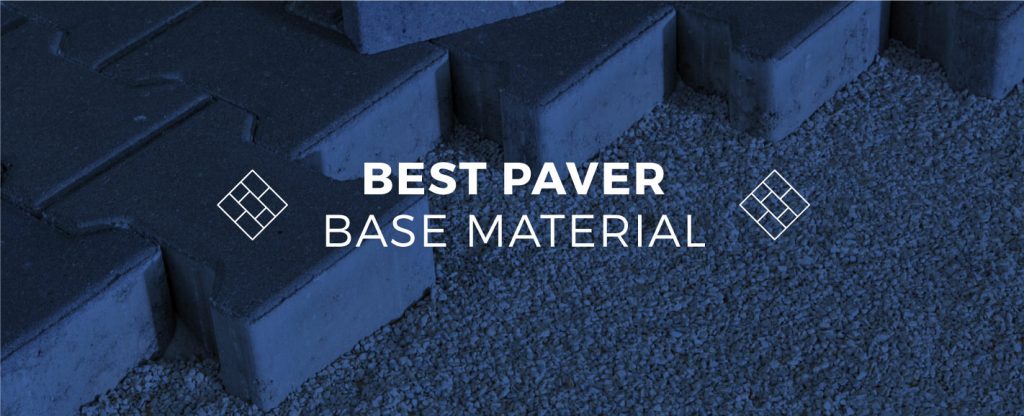
Jump-To:
- Types of Paver Base of operations Materials
- Paver Base Best Practices
- Find Quality Paving Materials
Concrete pavers are a versatile, attractive addition to any outdoor residential project. Their ease of installation makes for simple, efficient and timely dwelling set-up with the power to apply the space immediately. To reap the full benefits of your hardscaping for years to come up, information technology's essential to select and apply proper paver foundation materials.
A paver base encompasses several different material layers with varied back up functions. The back up system under pavers consists of three levels:
- Subgrade: The deepest level, composed of the compacted soil beneath the installation site
- Subbase: The middle support layer applied on top of the subgrade soil
- Base: The topmost fabric pavers are installed into
When selecting a base, you're choosing the materials that will anchor your pavers. Each textile exhibits backdrop that either helps or hinders your paver arrangement. For long-lasting, resilient pavers, consider the different types of paver bases to make the best determination for your budget and project.
Types of Paver Base Materials
Your base will determine whether your pavers remain smooth and level or abound uneven with time. Qualities of a suitable base of operations material include:
- Assart of proper h2o drainage
- The durability to back up the weight and forcefulness the pavers will endure
- The appropriate thickness for your subgrade material
Contractors and DIY homeowners apply a multifariousness of materials underneath pavers. Here are some things to know nearly the nearly common paver bases and their properties.
ane. Sand
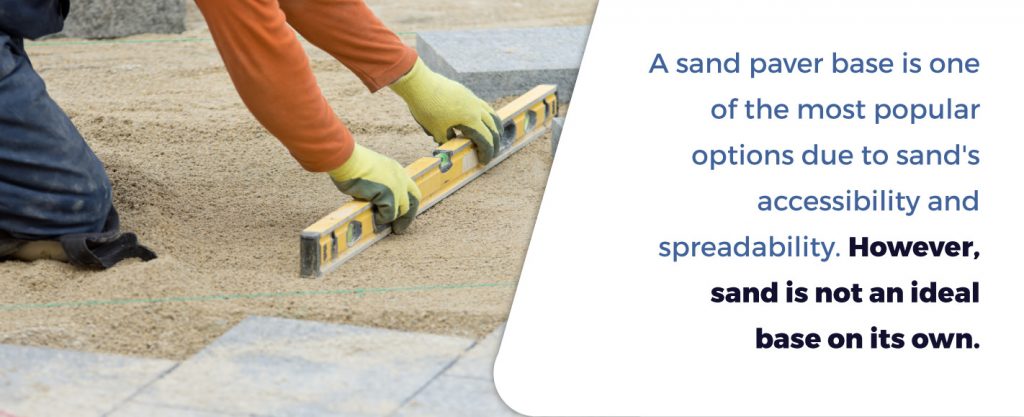
A sand paver base is 1 of the most pop options due to sand'south accessibility and spreadability. Yet, sand is not an ideal base on its own. Over time, sand shifts and can create an uneven foundation. If your foundation is anything but level, your pavers will show it.
Sand is often used in conjunction with crushed rock for increased durability. Because sand comes in many degrees of fineness and coarseness, not all types are suited for apply as a paver base. The Interlocking Concrete Pavement Establish recommends washed concrete sand every bit the best base sand for pavers.
Concrete sand, also known as bedding sand, is fibroid and doesn't trap excess moisture beneath the paver surface. This allows pavers to drain after a heavy pelting and maintain their structural integrity over time.
two. Crushed Rock
A crushed stone paver base is made of small stone pieces that have been broken and screened for uniformity. According to the Minerals Pedagogy Coalition, mutual rock types processed into crushed stone include limestone, dolomite, granite and trap rock. Stone amass comes in a variety of sizes, but well-nigh experts recommend 3/4-inch gravel for paver bases.
Crushed stone makes a solid paver base of operations considering it allows water drainage and is easy to work with. Like sand, crushed stone comes in several varieties. The best aggregate for paver bases is a quarry processed dumbo grade aggregate. Quarry processing creates a combination of iii/4-inch crushed stone and stone dust. This mixture binds well and increases durability, making it one of the best materials for maximum strength and cohesion.
3. Recycled Concrete Aggregate
Recycled physical amass (RCA) is a crushed stone alternative with environmental benefits. Crushed stone is mined every bit "virgin aggregate" before information technology is broken into pieces and sold. RCA is made by breaking down existing concrete into gravel. The RCA process has a smaller carbon output and takes less free energy than mining virgin aggregate, making it a sustainable option.
Though RCA functions similarly to crushed rock in a paver base of operations, it is impossible to know the different stone mixtures information technology contains. This unpredictability may make RCA a less reliable base option when compared to crushed stone. If you're interested in an RCA paver base of operations, talk to your provider about the quality of their materials to ensure your project runs every bit smoothly as possible.
iv. Rock Dust
Stone dust is a powdery mixture of finely ground stones that has a sand-like texture. Though it can exist a helpful base ingredient when mixed with other materials, most professionals recommend that you never use rock dust on its own every bit a base of operations.
Stone dust and finely basis stone called "screenings" fall into a material category that has excessive amounts of dust particles called fines. The fines trap big quantities of h2o that prevent the base layer from fairly draining. Co-ordinate to the Interlocking Concrete Pavement Institute, this water storage compromises a base'south power to bear and distribute loads. To keep your pavers safe and prevent them from shifting, opt for a base of operations textile with a niggling more than durability.
five. Compacted Soil
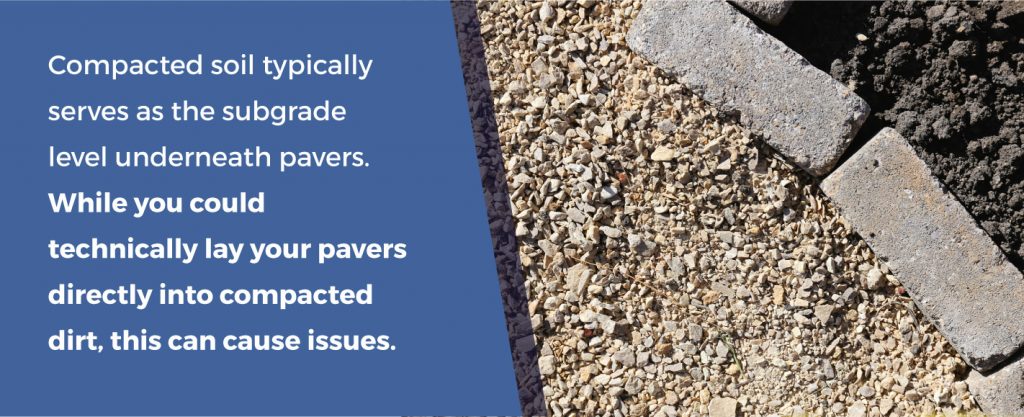
Compacted soil typically serves as the subgrade level underneath pavers. While yous could technically lay your pavers straight into compacted clay, this can cause problems, such as:
- Poor drainage: Compacted soil is not guaranteed to drain well. Prolonged wetness and excessive wet could cause instability and unevenness in your pavers.
- Initial unevenness: Depending on the location of your pavers, it may be challenging to get a completely even surface with compacted soil alone. Even slight hills and valleys will impact the pavers without a subbase or base level.
- Weather warping: If the soil underneath your pavers freezes in the wintertime, the ground may sink and buckle as information technology thaws unevenly. Whatever transformation in the basis will be reflected in your pavers, creating an dangerous walkway.
For security and evenness, it's best to install your pavers into other materials on top of compacted soil.
Locate A Dealer
Paver Base All-time Practices
Choosing a paver base of operations cloth is simply i aspect of creating a quality base. The way you lot construct the paver base ultimately impacts its effectiveness and longevity. Maybe the most practical tip for base construction is to accept your time.
Laboring over three base layers before you even begin to lay pavers may seem like a wasteful task. But the corporeality of time and precision you put into making your base of operations layers the correct thickness, compactness and evenness will pay off. A proper base can go along your pavers beautiful and functional for 20-25 years. If y'all're looking for stunning results, base edifice is not something to be rushed.
With your commitment to detail in mind, the following are some specific base of operations best practices to consider earlier yous install your pavers.
1. Get Started With Earthworks
Paver bases require several inches of excavation. Earlier you start excavation, you'll desire to ensure you won't hit whatever underground utility equipment. Calling the number 811 will automatically direct you to your state's call center and allow you to set an inspection two to three days in advance.
When your utilities are marked, it'due south time to dig a base. The purpose of this earthworks is twofold. It exposes area for the pavers to nestle into, and it clears loose dirt from the installation site. Loose soil is unstable and can't bear as much weight as hard, compacted earth. Removing this layer provides a stiff foundation for your paver base.
For added security, it's crucial to meaty your subgrade soil with a vibrating plate compactor. The more compressed your subgrade soil is, the less information technology will shift and settle over time. This will help keep your pavers level and in place for longer.
In improver to removing loose soil and compacting the subgrade soil, remove any grass, roots, large rocks or other debris from the paver installation site. This gives you an even surface to layer and build upon.
2. Dig Right Subgrade Depth and Gradient
The depth of your subgrade excavation volition depend on the type of soil yous have at the paver site. The different soil classifications include:
- Granular soil:Coarse-grained soil composed of gravel, sand or silt that crumbles easily when dry and exhibits very little cohesive strength
- Clay/cohesive soil: Fine-grained soil with high clay content that does non crumble, is difficult to break upward when dry and exhibits pregnant cohesion when wet
Granular soils brand strong subgrades that drain well, whereas dirt soils are weaker. For that reason, the Interlocking Concrete Pavement Constitute recommends a seven-inch subgrade thickness for granular soil and a ix-inch subgrade for clay soil. Be sure to match your soil with your excavation depth to continue your base sturdy.
In addition to depth, you'll need to comprise a slight slope gradient in your base for water drainage. With your paver'southward location and utilize in heed, decide which style the subgrade will need to slope to straight h2o away from the areas you'll use the most. Your paver site should be sloped 1/4-inch per pes to let proper runoff. This will prevent water buildup on the pavers themselves and help keep water abroad from your abode.
3. Employ Both Sand and Crushed Stone
As detailed above, the best paver base of operations is a quarry processed crushed rock subbase and a washed concrete sand base of operations. Crushed stone's stability paired with sand'southward spreadability makes a manageable, long-lasting base duo.
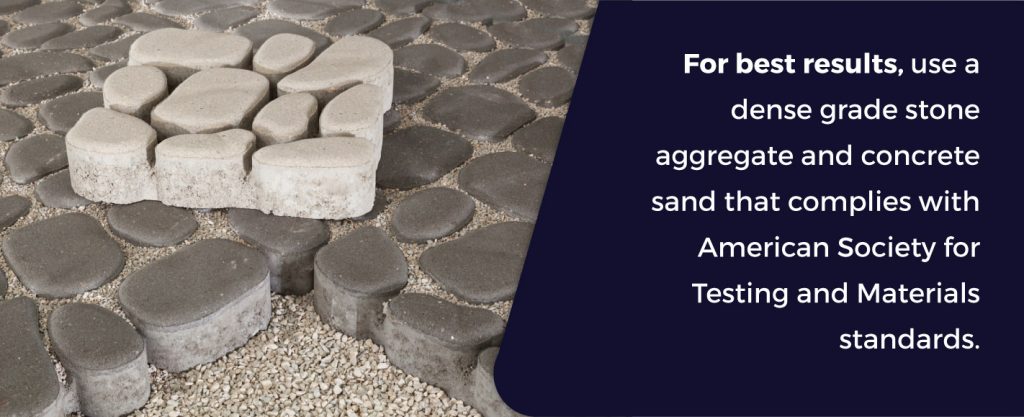
For all-time results, use a dense class stone aggregate and concrete sand that complies with American Lodge for Testing and Materials standards. ASTM C33 and CSA A23.1 is the recommended sand quality, merely ASTM C-144 and CSA 179 graded mason's sand is too acceptable. Talk to your supplier to make sure your materials align with these standards.
To calculate the amount of sand or crushed stone you should purchase, the Interlocking Concrete Pavement Found recommends the post-obit guidelines for every 100 square-foot surface area:
- Four inches thick: two tons of material
- Half-dozen inches thick: iii tons of textile
- Eight inches thick: four tons of textile
- Twelve inches thick: 6 tons of cloth
Your material providers should exist able to assist you with your quantity calculations to ensure you don't run out during base construction.
4. Meaty Your Subbase in Layers
When you brainstorm to build your subbase, you'll want to besprinkle thin layers of crushed rock and then compact and slope them. Compacting increases your base'south load-begetting abilities, while sloping maintains the proper water drainage plane.
To compact subbase layers, you'll need to hire a vibrating plate compactor. These machines look like pocket-sized, simplified push button mowers and are typically manually operated. Their engines vibrate a base plate, which can be used to compress your subbase particles closer together. Vibrating plate compactors come in a variety of sizes, so exist sure to hire a motorcar that makes sense for the size of your paver project.
For maximum effectiveness, complete your compaction 1 sparse layer at a time. Slightly wetting your crushed stone subbase may aid the compaction process. The more tightly-packed your subbase begins, the less likely you'll experience long-term settling underneath your pavers.
five. Brand the Subbase Authentic and Even
Your subbase thickness will depend on the type of subgrade soil you lot're roofing and the way your pavers volition exist used. Considering information technology'due south weaker, clay soil requires a thicker subbase than granular soil. Information technology is standard to apply a 4-inch crushed stone subbase over granular soil and a six-inch subbase over clay soil. These thicknesses work well for everyday pedestrian traffic.
If your pavers are located around a pool or will receive vehicle traffic, your subbase should be half-dozen to eight inches thick. Extra thickness beyond half-dozen to eight inches may help reinforce pavers that will support extremely heavy vehicles similar semi-trailers or campers.
To protect your pavers from unevenness, double your subbase thickness in areas that might freeze during the winter. The extra distance between the subgrade soil and the actual pavers will help mitigate any motion due to the footing freezing and thawing.
6. Completely Even the Base
Equally yous lay your concrete sand base, aim to make information technology less than 1.five inches thick. One time the sand is laid, y'all'll need to level, or screed, information technology. There are many types of tools to assistance level the sand base. You can utilise a apartment, heavy 2×four with an attached handle to shine out the sand, or you may consider renting a dedicated screed rail for the project. Whatever you decide, the finish goal is to have a completely smooth surface for your pavers.
Gently lay the broad side of a 2×4 onto the sand and gear up a level on it to ensure your surface is as even every bit possible.
7. Install Pavers Apace
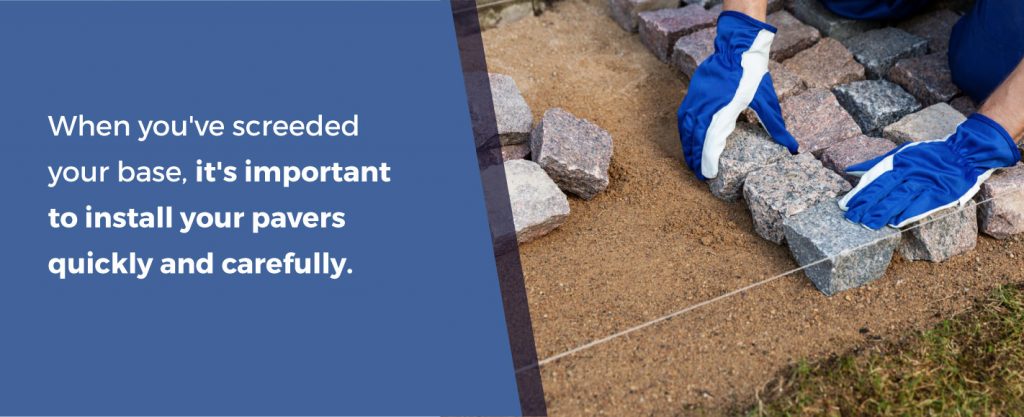
When you've screeded your base, it's important to install your pavers apace and advisedly. Leaving your base out overnight increases the chances that wind, debris or people volition disturb the apartment surface. Your base of operations may not be the only structure at stake if you don't work rapidly. Leaving pavers out overnight can increment their wet content, which may brand them susceptible to efflorescence after installation. Efflorescence is the presence of table salt deposits on your pavers, which gives them a white or greyish tint.
To avoid efflorescence and go on your base level intact, begin calculation pavers directly later screeding.
Find Quality Paving Materials at Nitterhouse Masonry
Withal you lot lay the foundation for your projection, Nitterhouse Masonry has durable pavers to match. Our paver selection covers a broad range of styles and uses, ensuring you'll find a versatile and affordable option. As a family-endemic and operated business organization for 5 generations, we empathize longevity. You can trust that our pavers will provide years of artful appeal and convenience after installation.
To learn more well-nigh our high-quality products, call us today at (717) 268-4137 or locate a dealer near you.
Source: https://www.nitterhousemasonry.com/blog/best-paver-base-material/
Post a Comment for "what is the best material that fish like to lay on"